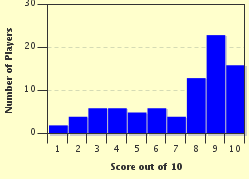Quiz Answer Key and Fun Facts
1. What sinister and spooky-sounding organ piece attributed to Bach is now firmly associated with the Halloween holiday and other tales of horror?
2. The music to this Stravinsky ballet actually sparked a riot at its premiere in 1913 for its bold, percussive rhythms and depictions of violent acts. What is the name of the ballet?
3. This song cycle's opening song, a prayer to Fortune/Lady Luck, generates such explosive power and force that it's borrowed liberally for movie soundtracks such as "Excalibur" and ad commercials galore. Name this 20th-century secular cantata composed by Carl Orff.
4. One of Beethoven's nine symphonies has a first movement with a climax that has been compared by musicologist Susan McClarty to be akin to the "premature orgasm of a frustrated rapist." This sets the stage for an hour-long symphony ending in a choral finale that is an ode to joy and brotherhood. Which symphony of Beethoven am I describing?
5. Mark Twain once said, "[Richard] Wagner's music is better than it sounds." Love him or hate him, Wagner certainly knew how to put on a show. Featuring earth-shattering chords and singing as the world goes up in flames, what is the name of the FINAL opera in his famous "Ring Cycle"?
6. The "Dance of the Knights" is a famous ballet dance scored by Sergei Prokofiev that features lumbering, emphatic, heavy rhythms representing the knights of two factions standing ready to fight. Which of his ballets is this piece from?
7. His eighth symphony is known as "the Apocalyptic", for its passages depicting the end of the world. Which 19th-century Austrian composer, known mostly today for his nine symphonies and his "Te Deum", was responsible for this work?
8. This German composer's first two major orchestral compositions came eighteen years apart, as he struggled to write a symphony worthy of Beethoven's legacy. In both pieces (the first, a piano concerto; the second, his first symphony) the music begins with loud forceful blows to the timpani. Who was this famous composer who eventually got over his fear of symphonies to write four great ones?
9. Gustav Mahler's second symphony features a psychotic dance with death (nicknamed the "Totentanz") as its first movement, and a harrowing depiction of the Last Judgement itself in the final movement. What is the apt nickname for this powerful symphony?
10. For our final piece, we're really going to crank it up a notch. What bombastic and nationalistic Tchaikovsky orchestral composition features cannon fire -- yes, real cannon fire -- as part of the music?
Source: Author
eyhung
This quiz was reviewed by FunTrivia editor
agony before going online.
Any errors found in FunTrivia content are routinely corrected through our feedback system.

